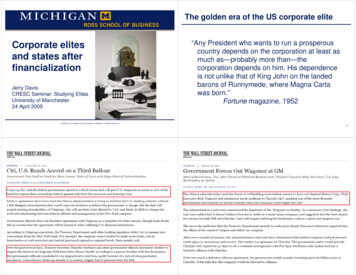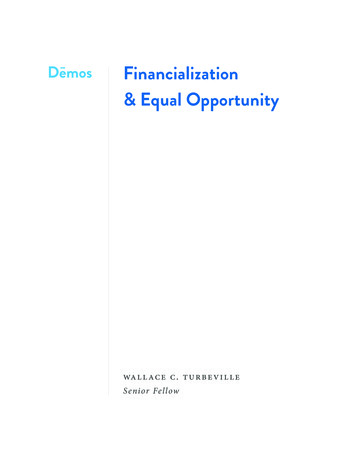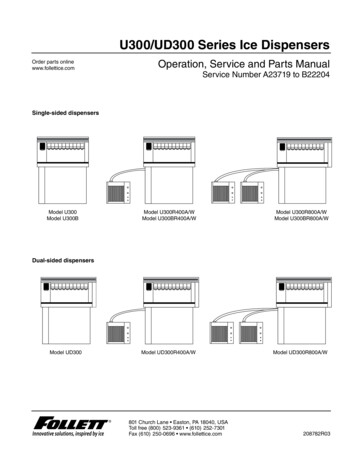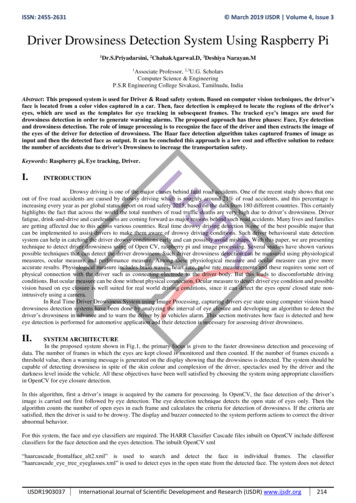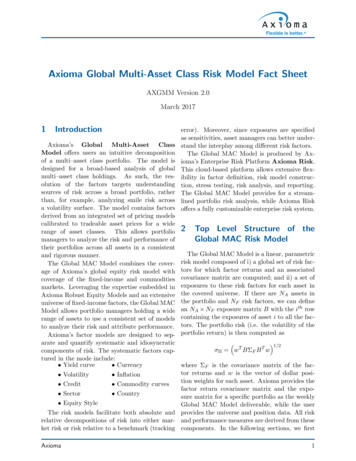
Transcription
A Model of Financialization of Commodities Suleyman BasakLondon Business Schooland CEPRAnna PavlovaLondon Business Schooland CEPRJune 10, 2015AbstractA sharp increase in the popularity of commodity investing in the past decade has triggered anunprecedented inflow of institutional funds into commodity futures markets, referred to as thefinancialization of commodities. In this paper, we explore the effects of financialization in amodel that features institutional investors alongside traditional futures markets participants.The institutional investors care about their performance relative to a commodity index. Wefind that in the presence of institutional investors prices and volatilities of all commodityfutures go up, but more so for the index futures than for nonindex ones. The correlationsamongst commodity futures as well as in equity-commodity correlations also increase, withhigher increases for index commodities. Within a framework additionally incorporatingstorage, we show how financial markets transmit shocks not only to futures prices but alsoto commodity spot prices and inventories. Commodity spot prices and inventories go up withfinancialization. In the presence of institutional investors shocks to any index commodityspill over to all storable commodity prices.JEL Classifications: G12, G18, G29Keywords: Asset pricing, indexing, commodities, futures, spot prices, institutions, moneymanagement, asset class. Email addresses: sbasak@london.edu and apavlova@london.edu. We thank participants at the Advancesin Commodity Markets, AFA, Arne Ryde, Cowles GE, EFA, MFS, NBER Asset Pricing, NBER Commodities,Paul Woolley Centre, Rothschild Caesarea, and SFI conferences and seminar participants at Bank Gutmann,Berkeley, BIS, BU, Chicago, Geneva, IDC, Imperial, Frankfurt, INSEAD, LBS, LSE, Luxembourg, Melbourne,Monash, Nova, Oxford, St. Gallen, Stanford, Stockholm, and Zurich, as well as Viral Acharya, Steven Baker,Francisco Gomes, Christian Heyerdahl-Larsen, Lutz Kilian, Andrei Kirilenko, Kjell Nyborg, Michel Robe, SylviaSarantopoulou-Chiourea, Olivier Scaillet, Dimitri Vayanos, Wei Xiong for helpful comments. We have alsobenefitted from valuable suggestions of Ken Singleton and two anonymous referees. Adem Atmaz providedexcellent research assistance. Pavlova gratefully acknowledges financial support from the European ResearchCouncil (grant StG263312).
1.IntroductionIn the past decade the behavior of commodity prices has become highly unusual. Commodityprices have experienced significant run-ups, and the nature of their fluctuations has changedconsiderably. An emerging literature on financialization of commodities attributes this behavior to the emergence of commodities as an asset class, which has become widely held byinstitutional investors seeking diversification benefits (Buyuksahin and Robe (2014), Singleton(2014)). Starting in 2004, institutional investors have been rapidly building their positionsin commodity futures.1 CFTC staff report (2008) estimates institutional holdings to have increased from 15 billion in 2003 to over 200 billion in 2008. Many of the institutional investorshold commodities through a commodity futures index, such as the Goldman Sachs CommodityIndex (GSCI), the Dow Jones UBS Commodity Index (DJ-UBS) or the S&P Commodity Index(SPCI). Tang and Xiong (2012) document that after 2004 the behavior of index commoditieshas become increasingly different from those of nonindex, with the former becoming more correlated with oil, an important index constituent, and more correlated with the equity market.These intriguing facts could be attributed to the entry of institutional investors into commodity futures markets. The financialization theory has far-reaching implications for regulation:the 2004-2008 run-up in commodity prices has prompted many calls for curtailing positions ofinstitutions who may have generated the run-up (see Masters’ (2008) testimony).While the empirical literature on financialization of commodities has been influential and hascontributed to the policy debate, theoretical literature on the subject remains scarce. Our goalin this paper is to model the financialization of commodities and to disentangle the effects ofinstitutional flows from the traditional demand and supply effects on commodity futures prices.We particularly focus on identifying the economic mechanisms through which institutions mayinfluence commodity futures prices, volatilities, and their comovement, as well as how theirpresence may affect commodity spot prices and inventories.We develop a multi-good, multi-asset dynamic model with institutional investors and standard futures markets participants. The institutional investors care about their performance1Related empirical literature dates the start of the financialization of commodity futures around 2004 (Buyuksahin et al. (2008), Irwin and Sanders (2011), Tang and Xiong (2012), Hamilton and Wu (2014), Boons, deRoon, and Szymanowska (2014), among others), and some of these works explicitly test for and confirm astructural break around 2004.1
relative to a commodity index. They do so because their investment mandate specifies a benchmark index for performance evaluation or because their mandate includes hedging againstcommodity price inflation. We capture such benchmarking through the institutional objectivefunction. Consistent with the extant literature on benchmarking (originating from Brennan(1993)), we postulate that the marginal utility of institutional investors increases with the index. In particular, institutional investors dislike to perform poorly when their benchmark indexdoes well and so have an additional incentive to do well when their benchmark does well.2 Allinvestors in our model invest in the commodity futures markets and the stock market. Prices inthese markets fluctuate in response to three possible sources of shocks: (i) commodity supplyshocks, (ii) commodity demand shocks, and (iii) (endogenous) changes in wealth shares of thetwo investor classes. We include in the index only a subset of the traded futures contracts. Wecan then compare a pair of otherwise identical commodities, one of which belongs to the indexand the other does not. We capture the effects of financialization by comparing our economywith institutional investors to an otherwise identical benchmark economy with no institutions.The model is solved in closed form, and all our results below are derived analytically.We first find that the prices of all commodity futures go up with financialization. However,the price rise is higher for futures belonging to the index than for nonindex ones. This happensbecause institutions strive to not fall behind when the index does well, thereby they valueassets that pay off more in those high-index states. Hence, relative to the benchmark economywithout institutions, futures whose returns are positively correlated with those of the index arevalued higher. In our model, all futures are positively correlated because they are valued usingthe same discount factor, and so all futures prices go up with financialization. But, naturally,the comovement with the index is higher for futures included in the index. Therefore, pricesof index futures rise more than those of nonindex. The larger the institutions, the more theyaffect pricing—or, more formally, the discount factor—making the above effects stronger.The volatilities of both index and nonindex futures returns go up with financialization.This is because, absent institutions, there are only two sources of risk: supply and demandrisks. With institutions present, some agents in the economy (institutional investors) face anadditional risk of falling behind the index. This risk is reflected in the futures prices and it2One may reasonably argue that there is also a category of institutional investors who want to perform wellwhen the index does poorly (e.g., hedge funds).2
raises the volatilities of futures returns. While the volatilities of all futures rise, those of indexfutures rise by more. Index futures are especially attractive to institutional investors becauseof their high comovement with the index. Hence, their volatilities rise enough to make themunattractive to the normal investors (standard market participants) so that they are willing tosell them to the institutions.We also find that the correlations amongst commodity futures as well as in the equitycommodity correlations increase with financialization. The often-quoted intuition for this riseis that commodity futures markets were largely segmented before the inflow of institutionalinvestors in mid-2000s, and institutions that entered these markets have linked them together,as well as with the stock market, through cross-holdings in their portfolios. We show thatthe argument does not need to rely on market segmentation, and that the rise in correlationsmay occur even under complete markets. Benchmarking institutional investors to a commodityindex leads to the emergence of this index as a new (common) factor in commodity futuresand stock returns. In equilibrium, all assets load positively on this factor, which increases theircovariances and their correlations. We show that index commodity futures are more sensitive tothis new factor, and so their covariances and correlations with each other rise more than thosefor otherwise identical nonindex commodities. Furthermore, we model explicitly demand shockswhich allows us to disentangle the effects of institutional investors from the effects of demandand supply (fundamentals), and conclude that the effects of financialization are sizeable.To address the question of how commodity spot prices and inventories are affected by financialization in our model, we follow the classical theory of storage (Deaton and Laroque (1992,1996)) and introduce intermediate consumption and storage decisions. Our main departurefrom the extant storage literature is that cash flows from storing a commodity are discountedwith a (stochastic) discount factor, which is influenced by all investors, including the institutions, and not at a constant riskless rate. We show that only storable commodity prices areaffected by financialization. In the presence of institutions, storable commodity inventories andprices are higher than in the benchmark economy, and again, this effect is stronger for commodities included in the index. Storing a commodity is akin to buying an asset whose payoffis the commodity price in the future net of storage costs. In our model this payoff is positivelyrelated to the payoff of the commodity index and hence the same intuition developed in the context of futures prices also applies to spot prices of storable commodities. Because the discount3
factor is affected by the institutional investors (and depends on the index), outside shocks toindex commodities spill over to prices and inventories of seemingly unrelated commodities. Incontrast, there are no spillovers of shocks to nonindex commodities. Outside shocks here arebroad and include shocks to a specific index commodity (related to its supply, supply volatility,or demand), stock market related (stock volatility and return), as well as inflows of institutions.These results challenge commonly held views that such shocks do not matter for commodityspot prices.1.1.Related LiteratureThis paper is related to several strands of literature. The two papers that have motivated thiswork are Tang and Xiong (2012) and Singleton (2014). Singleton examines the 2008 boom/bustin oil prices and argues that flows from institutional investors have contributed significantly tothat boom/bust. Tang and Xiong document that the comovement between oil and other commodities has risen dramatically following the inflow of institutional investors starting from 2004,and that the commodities belonging to popular indices have been affected disproportionatelymore. There was no difference in comovement patterns of index and nonindex commodities pre2004. Using a proprietary dataset from the CFTC, Buyuksahin and Robe (2014) investigatethe recent increase in the correlation between equity indices and commodities and argue thatthis phenomenon is due to the presence of hedge funds that are active in both equity and commodity futures markets. Recently, Henderson, Pearson, and Wang (2015) present new evidenceon the financialization of commodity futures markets based on commodity-linked notes.The impact of financialization on commodity futures and spot prices is the subject ofmuch ongoing debate. Surveys by Irwin and Sanders (2011) and Fattouh, Kilian, and Mahadeva (2013) challenge the view that increased speculation in oil futures markets in postfinancialization period was an important determinant of oil prices. Kilian and Murphy (2014)attribute the 2003-2008 oil price surge to global demand shocks rather than speculative demandshifts. Hamilton and Wu (2015) examine whether commodity index-fund investing had a measurable effect on commodity futures prices and find little evidence to support this hypothesis.There still remains lack of agreement whether trades by institutional investors affect commodity futures prices. Our view is that, given the size of commodity index traders’ (a proxy4
for institutional investors) futures holdings in the data, it is natural to expect that such tradersaffect prices. Furthermore, similar effects are reasonably well-established in other markets, especially equity markets. Starting from Harris and Gurel (1986) and Shleifer (1986), a large body ofwork documented that prices of stocks that are added to the S&P 500 and other indices increasefollowing the announcement and prices of stocks that are deleted drop—a phenomenon widelyattributed to the price pressure from institutional investors. Relatedly, a variety of studies document the so-called “asset class” effects: the “excessive” comovement of assets belonging to thesame index or other visible category of stocks (e.g., Barberis, Shleifer, and Wurgler (2005) forthe S&P500 vis-à-vis non-S&P500 stocks, Boyer (2011) for BARRA value and growth indices).These effects are attributed to the presence of institutional investors.The closest theoretical work on the effects of institutions on asset prices is the Lucas-treeeconomy of Basak and Pavlova (2013). Basak and Pavlova focus on index and asset class effectsin equity markets. Their model does not feature multiple commodities, nor is it designed toaddress some of the main issues in the debate on financialization; namely, whether institutionalinvestors impact commodity futures and spot prices, as well as inventories. Another relatedtheoretical study of an asset-class effect is by Barberis and Shleifer (2003), whose explanationfor this phenomenon is behavioral. However, they also do not explicitly model commoditiesand so cannot address some questions specific to the current debate on the financialization ofcommodities.Finally, there is a large and diverse literature going back to Keynes (1923) that studiesthe determination of commodity spot prices in production economies with storage and linksthe physical markets for commodities with the commodity futures markets.3 In this literature,Baker (2013) studies the financialization of a storable commodity. His interpretation of financialization is the reduction in transaction costs of households for trading futures. He focuseson a single commodity, while we consider multiple commodities, distinguishing between indexand nonindex ones. More generally, we contribute to this literature by modeling shareholders3In this strand of literature, a recent paper by Sockin and Xiong (2015) shows that price pressure frominvestors operating in futures markets (even if driven by nonfundamental factors) can be transmitted to spotprices of underlying commodities. Acharya, Lochstoer, and Ramadorai (2013) stress the importance of capitalconstraints of futures’ markets speculators and argue that frictions in financial (futures) markets can feedbackinto production decisions in the physical market. In a similar framework, Gorton, Hayashi, and Rouwenhorst(2013) derive endogenously the futures basis and the risk premium and relate them to inventory levels. Routledge, Seppi, and Spatt (2000) derive the term structure of forward prices for storable commodities, highlightingthe importance of the non-negativity constraints on inventories.5
of storage firms as risk-averse investors (some of which could be institutions), and highlight theinfluence of our discount factor channel and its role in generating cross-commodity spillovers.Methodologically, this paper contributes to the asset pricing literature by providing atractable multi-asset general equilibrium model with heterogeneous investors which is solvedin closed form. Pavlova and Rigobon (2007) and Cochrane, Longstaff, and Santa-Clara (2008)highlight the complexities of multi-asset models and provide analytical solutions for the twoasset case. As Martin (2013) demonstrates, the general multi-asset case presents a formidablechallenge. In contrast, our multi-asset model is surprisingly simple to solve. Our innovationis to replace Lucas trees considered in the above literature by zero-net-supply assets (futures)and model only the aggregate stock market as a Lucas tree. The model then becomes just assimple and tractable as a single-tree model.The remainder of the paper is organized as follows. Sections 2 and 3 present our model anddemonstrate how institutional investors affect commodity futures prices, volatilities, and theircomovement. Section 4 examines the effect of institutions on commodity inventories and spotprices and Section 5 concludes. Appendix A provides all proofs and the online Appendix Bpresents the economy with demand shocks.2.The ModelOur goal in this section is to develop a simple and tractable model of commodity futuresmarkets. We consider a pure-exchange multi-good, multi-asset economy with a finite horizonT . Uncertainty is resolved continuously, driven by a K 1-dimensional standard Brownianmotion ω (ω0 , . . . , ωK ) . All consumption in the model occurs at the terminal date T , whiletrading takes place at all times t [0, T ].Commodities.There are K commodities (goods), indexed by k 1, . . . K. The date-Tsupply of commodity k, DkT , is the terminal value of the process Dkt , with dynamicsdDkt Dkt [µk dt σk dωkt ],(1)where µk and σk 0 are constant. The process Dkt represents the arrival of news about DkT .We refer to it as the commodity-k supply news. The price of good k at time t is denoted byptk . There is one further good in the economy, commodity 0, which we refer to as the generic6
good. This good subsumes all remaining goods consumed in the economy apart from the Kcommodities that we have explicitly specified above and it serves as the numeraire. The date-Tsupply of the generic good is DT , which is the terminal value of the supply news processdDt Dt [µdt σdω0t ],(2)where µ and σ 0 are constant. Our specification implies that the supply news processes areuncorrelated across commodities (dDkt dDit 0, dDkt dDt 0, k, k ̸ i). This assumption isfor expositional simplicity; it can be relaxed in future work.Financial Markets.Available for trading are K standard futures contracts written oncommodities k 1, . . . , K. A futures contract on commodity k matures at time τ T and,upon maturity, gets rolled over to the next contract with maturity τ . This gets repeated tilltime T , at which time consumption takes place. The payoff of the contract is one unit ofcommodity k. Each contract is continuously resettled at the futures price fkt and is in zero netsupply. The gains/losses on each contract are posited to followdfkt fkt [µfk t dt σfk t dωt ],(3)where µfk t and the K 1 vector of volatility components σfk t are determined endogenously inequilibrium (Section 3).Our model makes a distinction between index and nonindex commodities because we seekto examine theoretically the asset class effect in commodity futures documented by Tang andXiong (2012). A commodity index includes the first L commodities, L K, and is defined asIt L 1/Lfit .(4)i 1This index represents a geometrically-weighted commodity index such as, for example, theS&P Commodity Index (SPCI). For expositional simplicity, our index weighs all commoditiesequally; this assumption is easy to relax.4In addition to the futures markets, investors can trade in the stock market, S, and aninstantaneously riskless bond. The stock market is a claim to the entire output of the economy4To model other major commodity indices such as the Goldman Sachs CommodityIndex and the Dow Jones LUBS Commodity Index, it is more appropriate to define the index as It i 1 wi fit , where the weights wiadd up to one. Such a specification is less tractable but one can show numerically that most of the implicationsare in line with those in our analysis below.7
at time T : DT Kk 1pkT DkT . It is in positive supply of one share and is posited to have pricedynamics given bydSt St [µSt dt σSt dωt ],(5)with µSt and σSt 0 endogenously determined in equilibrium. The bond in zero net supply. Itpays a riskless interest rate r, which we set to zero without loss of generality.5We note that our formulation of asset cash flows is standard in the asset pricing literature.The main distinguishing characteristic of our model is that it avoids the complexities of multitree economies. This is because only the stock market is in positive net supply, while all otherassets (futures) are in zero net supply. As we demonstrate in the ensuing analysis, this modelis just as simple and tractable as a single-tree model.Investors. The economy is populated by two types of market participants: normal investors,N , and institutional investors, I. The (representative) normal investor is a standard marketparticipant, with logarithmic preferences over the terminal value of her portfolio:uN (WN T ) log(WN T ),(6)where WN T is wealth or consumption.The institutional investor’s objective function, defined over his terminal portfolio value(consumption) WIT , is given byuI (WIT ) (a bIT ) log(WIT ),(7)where a, b 0. The institutional investor is modeled along the lines of Basak and Pavlova(2013), who study institutional investors in the stock market and also provide microfoundationsfor such an objective function, as well as a status-based interpretation.6 There is also a broaderinterpretation: recently consumers have become more sensitive to commodity prices, and oneway to capture this is via a formulation along the lines of (7). The objective function has twokey properties: (i) it depends on the index level IT and (ii) the marginal utility of wealth isincreasing in the benchmark index level IT . This captures the notion of benchmarking: the5This is a standard feature of models that do not have intermediate consumption. In other words, there isno intertemporal choice that would pin down the interest rate. Our normalization is commonly employed inmodels with no intermediate consumption (see e.g., Pastor and Veronesi (2012) for a recent reference).6Direct empirical support for the status-based interpretation of our model is provided in Hong, Jiang, andZhao (2015), who adopt the formulation in (7) in their analysis. Empirical work estimating objectives ofinstitutional investors remains scarce, with a notable exception of Koijen (2014).8
institutional investor is evaluated relative to his benchmark index and so he cares about theperformance of the index. When the benchmark index is relatively high, the investor strivesto catch up and so he values his marginal unit of performance highly (his marginal utility ofwealth is high). When the index is relatively low, the investor is less concerned about hisperformance (his marginal utility of wealth is low). We use the commodity market index as thebenchmark index because in this work we attempt to capture institutional investors with themandate to invest in commodities, most of whom are evaluated relative to a commodity index.An alternative interpretation of the objective function is that the institutional investor has amandate to hedge commodity price inflation; i.e., deliver higher returns in states in which thecommodity price index is high.7 We think of the terminal date T as the performance evaluationhorizon of institutional asset managers, usually 3-5 years (BIS (2003)).In this multi-good world, terminal wealth is defined as an aggregate over all goods, a consumption index (or consumption). We take the index to be Cobb-Douglas, i.e.,Wn Cnα00 Cnα11 · . . . · CnαKK ,where αk 0 for all k. For the case of Kk 0n {N , I},(8)αk 1, the parameter αk represents the expenditureshare on good k. Here we are considering a general Cobb-Douglas aggregator in which theweights do not necessarily add up to one, and hence we label αk as the “commodity demandparameter.”8 We take the commodity demand parameters to be the same for all investors inthe economy. Heterogeneity in demand for specific commodities is not the dimension we wouldlike to focus on in this paper.A change in αk represents a demand shift towards commodity k. A change in the demandparameter αk is the simplest and most direct way of modeling a demand shift, i.e., an outwardmovement in the entire demand schedule, as typical in classical demand theory (Varian (1992)).9In Section 3.3, we allow the demand parameters αk to be stochastic, in order to capture a morerealistic environment with demand shocks. Until then, we keep them constant so as to isolate7One could reasonably argue that there is also a category of institutional investors whose marginal utility isdecreasing in the index level, for example, hedge funds which may prefer higher payoffs when the index doespoorly.8In what follows,we are interested in comparative statics with respect to αk . The expenditure share on Kcommodity k, αk / k 0 αk , is monotonically increasing in αk . Hence all our comparative statics for αk are Kequally valid for expenditure shares αk / k 0 αk .9For example, an increase in demand for soya beans due to the invention of biofuels and concerns about theenvironment.9
the effects of supply shocks and the effects of financialization (fluctuations in institutionalwealth invested in the market) on commodity futures prices.The institutional and normal investors are initially endowed with fractions λ [0, 1] and(1 λ) of the stock market, providing them with initial assets worth WI0 λS0 and WR0 (1 λ)S0 , respectively. We will often refer to the parameter λ as the size of institutions.Starting with initial wealth Wn0 , each type of investor n N , I, dynamically chooses aportfolio process ϕn (ϕn1 , . . . , ϕnK ) , where ϕn and ϕnS denote the fractions of the portfolioinvested in the futures contracts 1 through K and the stock market, respectively. The wealthprocess of investor n, Wn , then follows the dynamicsdWnt WntK ϕnk t [µfk t dt σfk t dωt ] Wnt ϕnS t [µSt dt σSt dωt ].(9)k 13.Equilibrium Effects of Financialization of CommoditiesWe are now ready to explore how the financialization of commodities affects equilibrium prices,volatilities, and correlations. In order to understand the effects of financialization, we will oftenmake comparisons with equilibrium in a benchmark economy, in which there are no institutionalinvestors. We can specify such an economy by setting b 0 in (7), in which case the institutionin our model no longer resembles a commodity index trader and behaves just like the normalinvestor. Another way to capture the benchmark economy within our model is to set thefraction of institutions, λ, to zero.Equilibrium in our economy is defined in a standard way: equilibrium portfolios, asset andtime-T commodity prices are such that (i) both the normal and institutional investors choosetheir optimal portfolios, and (ii) futures, stock, bond and time-T commodity markets clear.Letting Mt,T to denote the (stochastic) discount factor or the pricing kernel in our model, byno-arbitrage, the futures prices are given byfkt Et [Mt,T pkT ].(10)The discount factor Mt,T is the marginal rate of substitution of any investor, e.g., the normalinvestor, in equilibrium.10
To develop intuitions for our results, it is useful to examine the time-T prices prevailing inour equilibrium. These are reported in the following lemma.Lemma 1 (Time-T equilibrium quantities). In equilibrium with institutional investors, weobtain the following characterizations for the terminal date quantities.αk DTCommodity prices: pkT (11); pkT pkT ,α 0 Dk T)1/LL (DT αiCommodity index: IT (12); IT I T ,α0 i 1 DiTStock market value: ST DTK αkk 0Discount factor: M0,Tα0;ST S T ,()b λ(IT E[IT ]) M 0,T 1 ,a b E[IT ](13)2M 0,Te(µ σ )T D0, DT(14)where the expectation of the time-T index value, E[IT ], is provided in the Appendix. Thequantities with an upper bar denote the corresponding equilibrium quantities prevailing in theeconomy with no institutions.Lemma 1 reveals that the price of good k decreases with the supply of that good DkT . Assupply DkT increases, good k becomes relatively more abundant. Hence, its price falls. A risein the supply of the generic good DT has the opposite effect. Now good k becomes more scarcerelative to the generic good. Hence, its price rises. These are classical supply-side effects.A positive shift in αk represents an increase in demand for good k. As a consequence, theprice of good k goes up. This is a classical demand-side effect. Since the index is given by 1/LIT Li 1 piT , the terminal index value inherits the properties of the individual commodityprices. In particular, it declines when the supply of any index commodity i DiT goes up, andrises when the supply of the generic good DT rises.We note that the time-T prices of commodities, and hence the commodity index coincidewith their values in the benchmark economy with no institutions. We have intentionally set up
model that features institutional investors alongside traditional futures markets participants. The institutional investors care about their performance relative to a commodity index. We nd that in the presence of institutional investors prices and volatilities of all commodity futures go up, but more so for the index futures than for nonindex .

